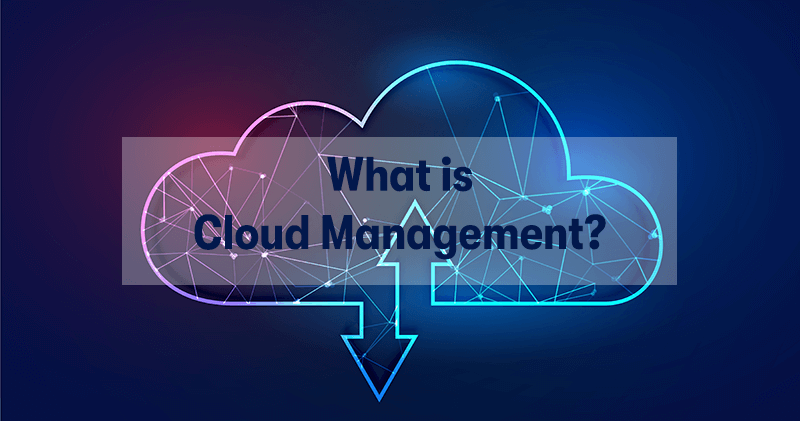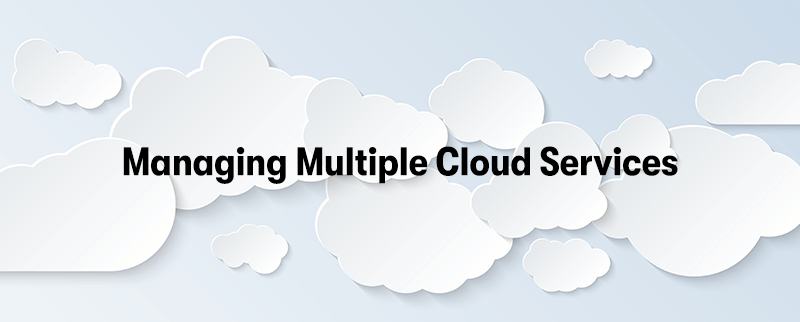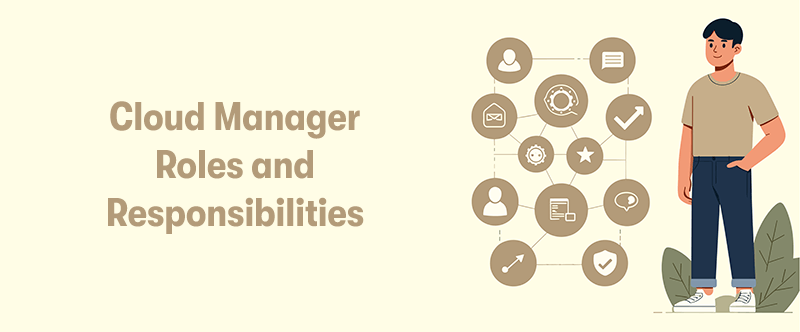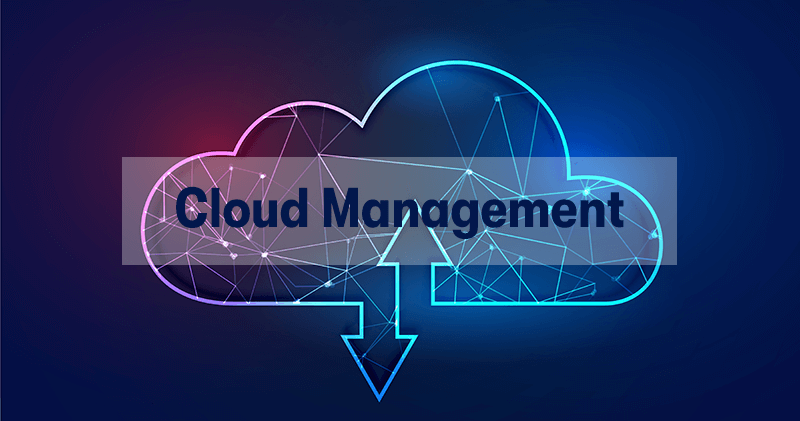Cloud Management
In the ever-evolving landscape of digital transformation, cloud management emerges as a cornerstone, pivotal in steering organisations through the intricacies of cloud computing. As businesses increasingly migrate to the cloud, harnessing its scalability, flexibility, and cost-efficiency, the demand for robust cloud management strategies becomes undeniable. This entails deploying and monitoring cloud resources and ensuring optimal performance, security, and cost-effectiveness.
The role of Cloud Management, integrating sophisticated tools and practices, is to provide a holistic oversight, enabling businesses to maximise the benefits of their cloud investments. In this context, understanding the nuances of cloud management is essential for organisations aiming to thrive in the digital era, ensuring they leverage cloud technologies to their fullest potential while navigating the challenges of security, compliance, and governance.
What is Cloud?

The term "Cloud" or "Cloud Computing" refers to delivering computing services over the internet, allowing individuals and organisations to use software and hardware that third parties manage at remote locations. These services can include servers, storage, databases, networking, software, analytics, and intelligence, with the aim of offering faster innovation, flexible resources, and economies of scale.
Users typically pay only for the cloud services they use, helping them reduce operating costs, run their infrastructure more efficiently, and scale as their business needs change. Cloud computing is characterised by its flexibility and accessibility. It enables users to access data and applications from anywhere, as long as they have internet access. It is a popular choice for businesses promoting remote work and digital collaboration. There are several types of cloud services, primarily categorised into:
Infrastructure as a Service (IaaS)
Provides virtualised computing resources over the internet. Users can rent IT infrastructures—servers and virtual machines (VMs), storage, networks, and operating systems—from a cloud provider on a pay-as-you-go basis.
Platform as a Service (PaaS)
Offers hardware and software tools over the internet, typically for application development. PaaS provides a platform allowing customers to develop, run, and manage applications without the complexity of building and maintaining the infrastructure typically associated with developing and launching an app.
Software as a Service (SaaS)
Delivers software applications over the internet on a subscription basis. It allows users to connect to and use cloud-based apps over the internet. Common examples include email, calendaring, and office tools (like Microsoft Office 365).
Function as a Service (FaaS)
A type of cloud service that allows developers to execute code in response to events without the complexity of building and maintaining the infrastructure. FaaS enables serverless applications, where the cloud provider dynamically manages the allocation and provisioning of servers.
Cloud services are offered from data centres worldwide, supporting a wide range of users, from individuals to large enterprises. The main benefits of cloud computing include cost savings, scalability, and accessibility. However, it also raises concerns about security and privacy that providers strive to address through various compliance and security measures.
What is Cloud Management?

Cloud management refers to the administrative control over public, private, hybrid, and multi-cloud environments. The process involves the deployment, management, monitoring, and optimisation of cloud resources and services to ensure they are operating efficiently, securely, and in alignment with an organisation's policies and compliance requirements.
Effective cloud management is critical for businesses to maximise the benefits of cloud computing while minimising risks and costs. Cloud management tasks and strategies can vary widely but generally include the following key areas:
Resource Deployment and Configuration
Automating the setup and provisioning of cloud resources to meet specific needs, such as computing power, storage, and networking components. This also includes configuring these resources in compliance with the organisation's policies and industry standards.
Performance Monitoring
Continuously monitor the performance of cloud services and infrastructure to ensure they operate optimally. This includes tracking the usage, response times, and availability of applications and services hosted in the cloud.
Cost Management and Optimisation
Managing and optimising cloud spending to ensure resources are utilised efficiently. This involves identifying and eliminating wasted resources, selecting appropriate resource types and sizes, and leveraging reserved instances or spot instances to reduce costs.
Security and Compliance
Ensuring that cloud deployments comply with relevant laws, regulations, and standards. This includes managing data protection measures, access controls, and threat detection mechanisms to safeguard data and applications in the cloud.
Disaster Recovery and Business Continuity
Implementing and managing backup and disaster recovery plans to ensure data is protected against loss and services can be quickly restored in the event of a failure or disaster.
Automation and Orchestration
Using automation tools and orchestration platforms to streamline the deployment, scaling, and management of cloud resources. This reduces manual intervention and enables more agile responses to changing requirements.
Service Management
Managing the end-to-end lifecycle of cloud services, from deployment to retirement, to ensure they meet user needs and business objectives. This includes service catalogue management, service level agreement (SLA) management, and customer support.
Cloud management platforms (CMPs) and tools are critical in facilitating these tasks, offering a unified interface for managing resources across various cloud environments. These platforms typically provide automation, analytics, security, and cost management capabilities, helping organisations manage their cloud resources effectively.
Effective cloud management ensures that cloud resources run efficiently, costs are controlled, security and compliance standards are met, and the overall cloud strategy aligns with the business objectives.
How to Manage the Cloud

Managing the cloud involves a comprehensive approach encompassing several key practices and strategies. These are designed to ensure efficient utilisation of cloud resources, cost-effectiveness, security, compliance, and overall operational excellence. Here's a guide on how to manage the cloud:
1. Establish Clear Governance and Policies
Define Cloud Governance Framework: Establish policies and guidelines for cloud usage, security standards, compliance requirements, and financial management.
Implement Identity and Access Management (IAM): Control who has access to what resources, ensuring users have the necessary permissions based on their roles.
2. Optimise Cloud Costs
Monitor and Analyse Cloud Spending: Use cloud cost management tools to track usage and expenses across different services and resources.
Implement Cost-Optimisation Practices: Leverage reserved instances, spot instances, and auto-scaling to optimise costs. Regularly review and adjust resource allocations based on usage patterns.
3. Ensure Security and Compliance
Apply Robust Security Measures: Implement encryption, firewall configurations, and intrusion detection systems to protect your data and applications.
Comply with Regulations: Stay informed about relevant regulations (GDPR, HIPAA, etc.) and ensure your cloud environment is compliant.
Regular Security Assessments: Conduct regular security audits and vulnerability assessments to identify and mitigate risks.
4. Use Automation and Orchestration
Automate Repetitive Tasks: Use automation tools for provisioning, configuration, and deployment processes to reduce manual errors and save time.
Orchestrate Workflows: Implement orchestration tools to efficiently manage interconnections and dependencies between cloud services and resources.
5. Monitor Performance and Reliability
Implement Monitoring Tools: Use cloud monitoring and management tools to track your applications and infrastructure's performance, availability, and health.
Set Up Alerts and Notifications: Configure alerts for performance thresholds, security incidents, and other critical events.
6. Plan for Disaster Recovery and Business Continuity
Implement Backup Solutions: Regularly back up data and configurations to protect against data loss.
Develop a Disaster Recovery Plan: Ensure you have a strategy for quickly restoring services in case of an outage or disaster.
7. Leverage Multi-Cloud and Hybrid Cloud Strategies
Assess Needs for Multi-Cloud or Hybrid Cloud: Determine if using multiple cloud providers or a combination of cloud and on-premises resources meets your business needs for flexibility, compliance, and risk management.
Implement Cloud Management Platforms (CMPs): Use CMPs to manage multiple cloud environments cohesively, providing a unified view and control over diverse resources.
8. Invest in Training and Skills Development
Educate Your Team: Ensure your team has the necessary skills and knowledge to manage cloud resources effectively. This may involve training on specific cloud platforms, security practices, and management tools.
9. Regularly Review and Adjust Your Cloud Strategy
Conduct Regular Reviews: Assess your cloud deployment's effectiveness regularly, looking for areas of improvement in cost, performance, security, and compliance.
Stay Informed About Cloud Innovations: Keep up with new services, features, and best practices in cloud computing to continuously refine and improve your cloud management strategy.
Effective cloud management is an ongoing process that requires attention to detail, strategic planning, and continual adjustment to new challenges and opportunities. By following these guidelines, organisations can maximise the benefits of cloud computing while minimising risks and costs.
Managing Multiple Cloud Services

Managing multiple cloud services, often referred to as multi-cloud management, involves overseeing the use of various cloud services from different providers to achieve specific business objectives. This approach allows organisations to leverage the strengths of different cloud providers, avoid vendor lock-in, enhance business continuity, and meet compliance and data sovereignty requirements. However, it also introduces complexity regarding integration, security, cost management, and consistent operations. Here are key strategies for effectively managing multiple cloud services:
1. Establish a Multi-Cloud Strategy
Define Business Objectives: Understand the reasons behind adopting a multi-cloud approach, whether for reliability, cost-effectiveness, geographic presence, or specific features.
Assess Workload Requirements: Evaluate the requirements of different workloads and match them with the strengths of each cloud provider.
2. Implement Cloud Management Platforms (CMPs)
Use CMPs: Deploy cloud management platforms that support multi-cloud environments. These platforms offer tools for provisioning, monitoring, and managing resources across different clouds, providing a unified management interface.
3. Centralise Identity and Access Management (IAM)
Unified IAM: Adopt a centralised identity and access management system that works across all cloud platforms to streamline access controls, authentication, and authorisation processes.
4. Adopt Cloud Agnostic Tools and Practices
Leverage Cloud-Agnostic Tools: Use tools and technologies that are compatible with multiple cloud environments, such as containers, Kubernetes for orchestration, and terraform for infrastructure as code (IaC), to facilitate portability and consistency.
5. Focus on Security and Compliance
Implement Consistent Security Policies: Develop and enforce uniform security policies across all cloud platforms, including data encryption, firewall configurations, and vulnerability scanning.
Compliance Management: Ensure your multi-cloud strategy adheres to regulatory and compliance requirements by applying consistent compliance controls across environments.
6. Optimise Costs Across Clouds
Monitor and Analyse Spending: Use cost management tools to monitor usage and costs across different cloud services and identify opportunities for savings.
Apply Best Practices for Cost Optimisation: Leverage reserved instances, spot pricing, and auto-scaling features across clouds to optimise costs.
7. Ensure Interoperability and Integration
Design for Interoperability: Plan and implement solutions ensuring seamless integration and data exchange between cloud services, considering API compatibility and network connectivity.
8. Develop a Comprehensive Backup and Disaster Recovery Plan
Cross-Cloud Backup and DR: Ensure your backup and disaster recovery plans cover all cloud environments, leveraging the geographical diversity and redundancy of multiple clouds for enhanced resilience.
9. Invest in Training and Skills Development
Cross-Training for Teams: Train your IT and development teams on the specific technologies and management tools used across the different cloud platforms to build expertise in multi-cloud environments.
10. Monitor Performance and Reliability
Implement Unified Monitoring: Use monitoring tools to track performance, availability, and health metrics across all cloud services to ensure optimal operation and detect issues early.
11. Regularly Review and Adjust Your Multi-Cloud Approach
Continuous Evaluation: Regularly assess your multi-cloud strategy and operations to ensure they align with evolving business goals, technological advancements, and market trends.
Effectively managing multiple cloud services requires careful planning, robust management tools, and ongoing adjustment to align with business needs and technological changes. By adopting a strategic approach to multi-cloud management, organisations can enhance flexibility, optimise costs, and improve overall efficiency.
What is a Cloud Manager?
A Cloud Manager refers to either a professional role or a software solution designed to oversee and facilitate the management of cloud computing resources. Whether referring to a professional role or a software solution, a Cloud Manager plays a crucial role in ensuring that cloud resources are used effectively, securely, and in a way that aligns with the organisation's strategic goals.
Cloud Manager Roles and Responsibilities

The roles and responsibilities of a Cloud Manager are multifaceted, encompassing strategic planning, operational management, technical oversight, and financial governance of cloud resources within an organisation. The exact duties can vary based on the size and type of the organisation and the complexity of its cloud infrastructure. However, several core responsibilities are common across most Cloud Manager positions:
Strategic Planning and Advisory
Developing the Cloud Strategy: Formulate a comprehensive cloud strategy that aligns with the organisation's business goals, including cloud adoption plans, cloud architecture design, and service model selection (IaaS, PaaS, SaaS).
Guiding Cloud Adoption: Advise on best practices for cloud migration and deployment, helping to identify which workloads to move to the cloud and in what sequence to optimise performance and cost.
Financial and Cost Management
Budgeting and Cost Optimisation: Monitor and manage cloud expenditures to ensure they stay within budget while optimising resource utilisation and cost-effectiveness through techniques such as reserved instances, auto-scaling, and identifying underutilised resources.
Cost-Benefit Analysis: Perform analyses to justify cloud investments, including total cost of ownership (TCO) and return on investment (ROI) calculations.
Technical Oversight and Management
Resource Management: Oversee the deployment, management, and optimisation of cloud resources, including compute, storage, and network services, to meet the needs of the organisation.
Performance Monitoring: Ensure the cloud environment meets performance requirements, implementing monitoring and analytics tools to track service levels and respond to issues as they arise.
Security and Compliance: Develop and enforce policies and practices to secure cloud environments, manage data protection, and ensure compliance with relevant regulations and standards.
Disaster Recovery and Business Continuity: Plan and implement disaster recovery (DR) and business continuity strategies to protect data and maintain operations during an outage or disaster.
Vendor and Stakeholder Management
Vendor Relations: Manage relationships with cloud service providers, including negotiating contracts, managing service level agreements (SLAs), and resolving issues.
Collaboration and Communication: Work closely with IT teams, developers, business units, and senior management to ensure cloud initiatives are aligned with organisational objectives and that stakeholders are informed of the benefits, risks, and progress of cloud projects.
Innovation and Continuous Improvement
Staying Informed: Keep abreast of developments and trends in cloud computing, including new tools, services, and best practices, to drive continuous improvement and innovation within the organisation's cloud strategy.
Training and Skills Development: Identify training needs and opportunities for team members to ensure they possess the necessary skills to effectively support the organisation's cloud environment.
Policy Development and Enforcement
Governance: Establish governance frameworks to manage risk, ensure data integrity, and enforce policies consistently across the cloud environment.
Identity and Access Management (IAM): Oversee the implementation of IAM policies and tools to securely control access to cloud resources.
A Cloud Manager's role is critical in navigating the complexities of cloud computing to leverage its benefits effectively while mitigating risks. This position requires a blend of technical acumen, strategic thinking, financial management skills, and the ability to communicate and collaborate across various levels of an organisation.
Final Notes on Cloud Management
In conclusion, navigating the realm of cloud computing, whether it's understanding its fundamentals, managing cloud environments, or delving into a Cloud Manager's specific roles and responsibilities, is crucial for organisations aiming to leverage the cloud's full potential. Effective cloud management encompasses strategic planning, cost optimisation, technical oversight, security, compliance, fostering innovation, and ensuring business continuity.
The Cloud Manager plays a pivotal role, balancing technical acumen with strategic insight to guide organisations through cloud adoption and optimisation complexities. As cloud computing continues to evolve, staying informed and adaptable is key to harnessing its benefits, driving efficiency, and maintaining competitiveness in the digital landscape.


